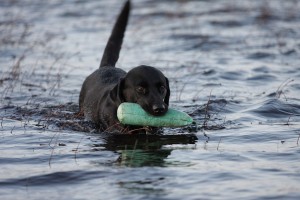 Labrador Retrievers have been described as having descended the St. John’s Dogs of Newfoundland or “Newfies”. These water dogs were used on boats to assist fishermen in pulling in nets and saving drowning victims. Because of their outstanding temperament and qualities they were adapted and trained to help hunt and retrieve fowl. They are superior retrievers and one of the most common breeds today. Labradors are often chosen to be service dogs or guide dogs for the blind.
Labrador Retrievers have been described as having descended the St. John’s Dogs of Newfoundland or “Newfies”. These water dogs were used on boats to assist fishermen in pulling in nets and saving drowning victims. Because of their outstanding temperament and qualities they were adapted and trained to help hunt and retrieve fowl. They are superior retrievers and one of the most common breeds today. Labradors are often chosen to be service dogs or guide dogs for the blind.
Labrador Retrievers are popular pets due to easygoing nature and are favored by even non-hunting families. Labradors are very trainable and it is recommended that they start training while in puppyhood. If they are socialized in the kind way all puppies should be, Labradors grow up to be incredibly friendly, obedient, patient, and energetic dogs. Labradors are great playmates with children and other dogs. They enjoy exercising and being active outdoors. Being bred to retrieve in lakes and the ocean, Labrador Retrievers are excellent swimmers and love water. They will share, enjoy socializing, and love being treated like one of the family. Labradors thrive on companionship and enjoy being part of family.
 While Labradors are not known for having issues with aggression, some lines have a number of less desirable traits. Some pups have difficulty focusing their attention, and their over-friendliness can become annoying. Their over-friendliness can even become dangerous as they reach adolescence and joyously jump up on people to greet them. These problems are easily solved by skillful use of rewards while the dog is still a pup. It’s important to train a Labrador pup – with reward based methods – that all four feet belong on the floor, and that sitting is the best way to greet people. Labradors learn incredibly quickly to do anything the owner rewards, be it with food or with attention. A Labrador pup will quickly learn to concentrate and even do a long ‘stay’ once they understand that this is rewarded behavior. This trainability means that owner mistakes can easily train annoying (though harmless) behavior, more so than with many other breeds. You don’t have to punish the Labrador pup, but owners should be careful not to reward any behavior that will become annoying when the pup gets bigger.
While Labradors are not known for having issues with aggression, some lines have a number of less desirable traits. Some pups have difficulty focusing their attention, and their over-friendliness can become annoying. Their over-friendliness can even become dangerous as they reach adolescence and joyously jump up on people to greet them. These problems are easily solved by skillful use of rewards while the dog is still a pup. It’s important to train a Labrador pup – with reward based methods – that all four feet belong on the floor, and that sitting is the best way to greet people. Labradors learn incredibly quickly to do anything the owner rewards, be it with food or with attention. A Labrador pup will quickly learn to concentrate and even do a long ‘stay’ once they understand that this is rewarded behavior. This trainability means that owner mistakes can easily train annoying (though harmless) behavior, more so than with many other breeds. You don’t have to punish the Labrador pup, but owners should be careful not to reward any behavior that will become annoying when the pup gets bigger.
 Without regular exercise Labradors can become obese and bored, which can lead to destructive behaviors such as chewing on things. Labradors do not make great guard dogs because they have a tendency to be friendly to everyone. They do have an acute sense of smell and an alert instinct and to alarm owners that someone may be entering the yard or house.
Without regular exercise Labradors can become obese and bored, which can lead to destructive behaviors such as chewing on things. Labradors do not make great guard dogs because they have a tendency to be friendly to everyone. They do have an acute sense of smell and an alert instinct and to alarm owners that someone may be entering the yard or house.
Another problem with the Labrador is that shelters often use the breed’s name to disguise the fact that a shelter dog is part pit bull or some other ‘bull breed’ mix. It can be impossible to tell by looking at a ‘Labrador mix’ whether it is in fact part Labrador or if it’s really a ‘bully’ mix. If you decide that the Labrador is the breed for you, the only way to be sure you are really getting a Labrador is to buy a pup from a reputable breeder.
Labrador Retrievers are large dogs, weighing 55 to 100 lbs. They are average shedders and have minimal grooming requirements. Labradors have a life expectancy of 10-12 years. They are healthy, overall, but are prone to hip and elbow dysplasia, ear infections, and eye disorders.
In North America, from 1982-2015, Labrador Retrievers have seriously attacked 60 humans, resulting in 3 fatalities. Labrador Retriever mixes have seriously attacked 36 humans, resulting in 2 fatalities. Pit bull type dogs are often listed as Labrador Retriever mixes and it is possible that these numbers may be incorrect due to breed mislabeling


I love Labrador Retrievers .